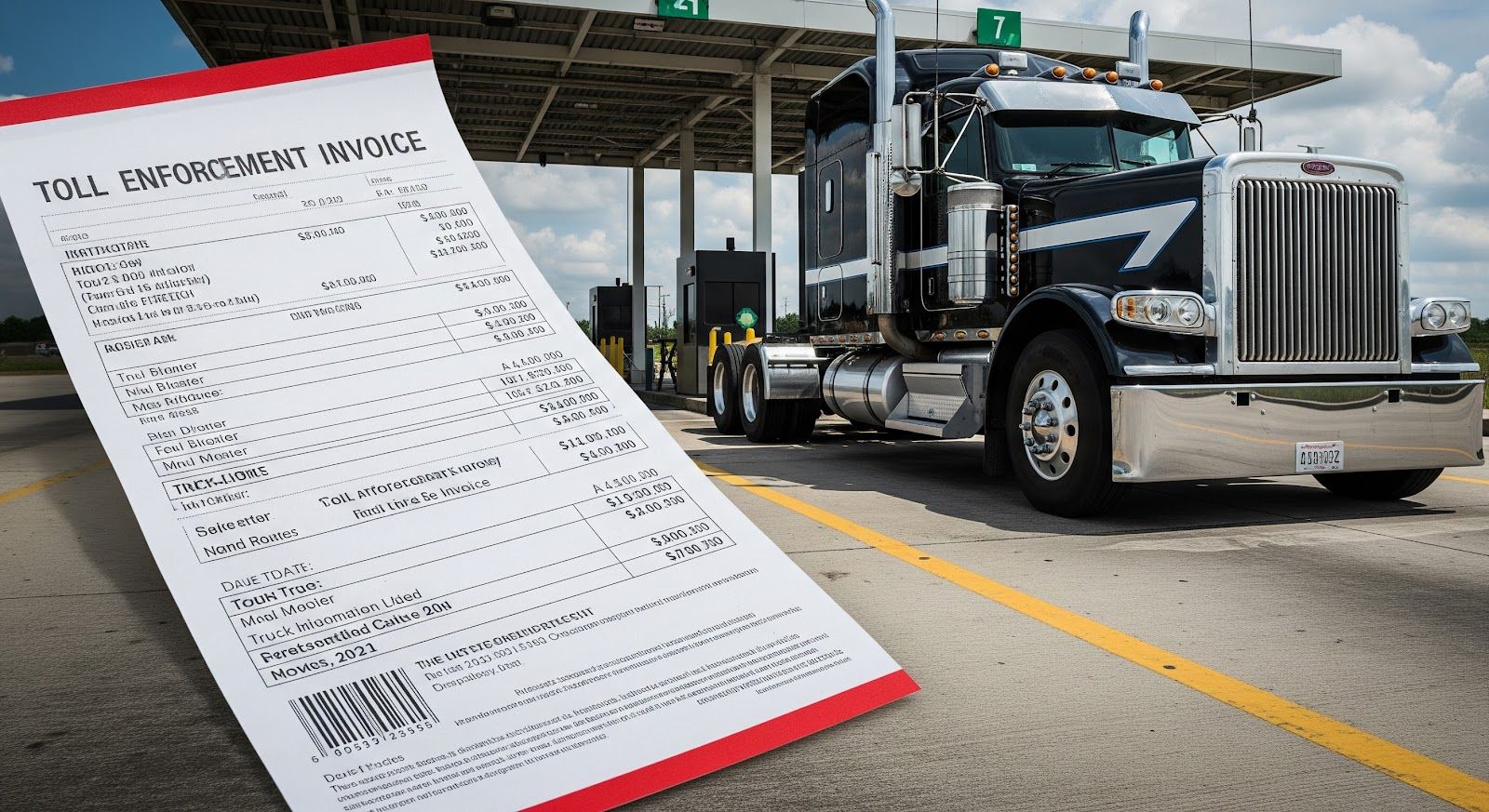Understanding Your Toll Enforcement Invoice: What Fleets Need to Know

For fleet managers and owner-operators, toll enforcement invoices are not just a nuisance—they're a costly operational disruption. What should be a simple toll charge of $3 can quickly balloon into a $60 fine when enforcement fees and late penalties are added. Multiply that across dozens of vehicles and hundreds of trips, and the impact becomes significant—both financially and administratively.
This guide is designed to help you understand what toll enforcement invoices are, why they happen, and most importantly, how to avoid them. Whether you're running a small operation or managing a nationwide fleet, knowing how to deal with these invoices can save you time, stress, and thousands of dollars each month.
What Is a Toll Enforcement Invoice?
A toll enforcement invoice is a bill issued by a tolling authority when a toll transaction cannot be processed through the standard method—usually a transponder tied to a prepaid account. Instead of the toll being deducted automatically, the authority sends an invoice directly to the vehicle’s registered owner, often with additional fees and penalties attached.
Purpose of a Toll Enforcement Invoice
Toll enforcement invoices are meant to ensure tolling authorities still receive payment when the original tolling method fails. They also serve as a deterrent against unpaid tolls by tacking on enforcement or violation fees, which can range from $25 to over $100 per transaction, depending on the state and road.
Common Reasons Fleets Receive Toll Enforcement Invoices
For fleets, enforcement invoices can pile up quickly due to a few avoidable errors or oversights:
Missed Transponder Reads
This happens when the transponder mounted on the vehicle doesn’t register at the toll gantry. Causes can include:
- Faulty or inactive transponders
- Poor placement on the windshield
- Signal interference from metal tinting or improper vehicle height
If the system can’t read the transponder, it defaults to a license plate scan—which, if unlinked to a valid account, triggers an invoice.
Toll-by-Plate Scenarios
In areas where toll-by-plate is used, cameras capture the vehicle’s license plate instead of relying on a transponder. If that plate isn't connected to a valid toll account, an invoice is mailed. This often happens with:
- Rental or leased vehicles
- Newly acquired units not yet added to the toll account
- Trailers with license plates that trigger enforcement due to misreads
Expired or Improperly Mounted Transponders
Many tolling authorities have strict requirements on where and how transponders must be installed. If the device is:
- Mounted incorrectly (too low, behind tint, etc.)
- Expired or deactivated
- Damaged from wear, extreme temperatures, or tampering
The system may not read it properly, and you’ll receive an enforcement invoice instead of a clean transaction.
Incorrect or Missing License Plate Registrations
Tolling systems often rely on accurate plate-to-account mapping. Fleets that forget to update their toll provider with new plates or VINs can be flagged. Common scenarios include:
- Adding a new truck or trailer and forgetting to register it
- Plate replacements that aren’t synced with the system
- Mismatches between the plate and the vehicle profile on file
Left unchecked, these issues can result in dozens of invoices each month, stacking up into thousands of dollars in avoidable fees.
Hidden Costs Behind the Invoice
At first glance, a toll enforcement invoice might seem like just a minor inconvenience—maybe a small penalty tacked onto a missed toll. But for fleets, these invoices can snowball into major operational costs, often hidden in layers of fees and administrative burdens. What looks like a $3 toll can quickly become a $60+ charge, repeated across dozens or even hundreds of vehicles.
Let’s break down where these costs come from:
1. Base Toll
This is the original toll amount that should’ve been charged if everything went smoothly—typically ranging from $2 to $15, depending on the road and distance traveled. On its own, this is manageable. But once enforcement gets involved, things change fast.
2. Enforcement or Violation Fees
If the tolling authority cannot process the transaction through a fleet’s transponder or toll account, they issue a toll enforcement invoice that includes a violation fee—meant to cover the cost of identifying the vehicle, mailing the invoice, and pursuing payment.
- Typical range: $25 to $100 per violation
- Common example: A $3 toll turns into a $50–$60+ charge after enforcement fees are added
- Repeat violations mean these fees multiply rapidly across fleet trips
These costs are rarely negotiable and are often required to be paid immediately to avoid additional late penalties.
3. Administrative Penalties & Late Fees
If the invoice is not paid promptly—either because it was overlooked, misrouted, or delayed in processing—further administrative charges are applied, including:
- Late fees
- Collection fees
- Suspension risks (in some jurisdictions, unpaid tolls can lead to vehicle registration holds)
What starts as a $3 toll can easily evolve into a $100+ charge per vehicle, per trip.
4. Real-World Impact: The Service Trucking Inc. Example
Before implementing a toll management solution, Service Trucking Inc.—a family-owned fleet based in Florida—was dealing with:
- 30+ violations every month
- $3,000 to $5,000/month in fees from misreads, enforcement invoices, and duplicate toll charges
- Delayed billing (2–3 weeks), causing duplicate charges and reconciliation challenges
- Significant admin time spent late at night manually fixing toll-related errors
These hidden costs were unsustainable—not only draining their budget but also burdening their internal team with hours of unnecessary work.
After switching to Bestpass, they dramatically cut violations and eliminated late-night admin tasks, highlighting how unseen invoice costs can quietly erode fleet profitability.
The real cost of a toll enforcement invoice isn’t just in the fine—it’s in the repetition, the manual effort, and the missed opportunities to optimize fleet performance. Managing tolls proactively is not just a convenience—it’s a bottom-line business decision.
Common Fleet Mistakes That Lead to Toll Enforcement Invoices
Toll enforcement invoices often feel like they come out of nowhere—but in reality, most are caused by small, preventable errors within a fleet’s operational processes. These oversights might not seem like a big deal individually, but they can quickly escalate into costly violations if not addressed proactively.
Here are some of the most common mistakes fleets make that lead to enforcement invoices:
1. Not Updating License Plates or Vehicle Details
One of the biggest culprits behind toll enforcement issues is outdated or incorrect vehicle information.
- Why it matters: Tolling systems often rely on plate recognition as a backup if the transponder fails. If your license plate isn’t registered correctly with the toll authority or toll management provider, you’ll get hit with an invoice.
- Common scenarios:
- Recently acquired or leased vehicles that haven’t been added to the toll account
- Plates that were replaced due to damage or re-registration
- Changes to vehicle ownership, fleet ID numbers, or tags that aren’t synced with the tolling database
Result: Even with a working transponder, an unregistered plate can trigger a toll-by-plate charge, enforcement fee, or violation.
2. Relying on Outdated or Incompatible Tolling Systems
Some fleets are still using legacy tolling solutions or regional-only passes that don’t provide full coverage across all routes their vehicles travel.
- Why it matters: As vehicles cross state lines or toll zones with incompatible systems, tolls may not register correctly—especially on roads that now rely on all-electronic tolling (AET).
Example: A truck using an East Coast-only E-ZPass system may be unrecognized on Midwestern or West Coast toll roads.
Result: Missed transactions mean tolls are processed via plate, leading to enforcement invoices with added fees—and possibly duplicate billing if the toll eventually processes through both methods.
3. Poor Transponder Placement or Installation
Even the best transponder won’t work if it’s installed incorrectly. And yes—placement matters more than most fleets think.
- Why it matters: Transponders have specific mounting requirements. If installed too low, behind metallic windshield tint, or upside-down, they can fail to trigger the toll gantry.
- Fleet examples:
- Improper mounting in new trucks
- Windshield tint or dashboard-mounted devices interfering with signal
- Transponders placed in glove compartments or tucked behind mirrors
Result: Misreads or no reads at all, resulting in toll-by-plate charges, delayed billing, and enforcement notices.
4. Lack of Real-Time Toll Tracking
Many fleets rely on manual toll reconciliation or review their transactions weeks after the fact—which makes catching issues early almost impossible.
- Why it matters: Delayed or missing toll data means fleets can’t see:
- When violations occur
- Where tolls were misread or missed entirely
- Duplicate charges on the same trip
- Without real-time visibility, small problems like a misconfigured transponder or unregistered plate can persist for weeks before anyone notices.
Result: By the time you’re reacting, you’re already paying the penalty.
Avoiding toll enforcement invoices starts with proactive toll management—keeping your vehicle data current, ensuring transponders are properly installed, and using a solution that provides real-time monitoring and full national toll coverage. These small improvements can prevent a flood of violations and fees.
How to Prevent Toll Enforcement Invoices
Toll enforcement invoices might feel inevitable—but they’re not. With the right tools, processes, and preventative measures, fleets can drastically reduce or eliminate violations, avoid unnecessary fees, and streamline toll operations. Here's how to stop enforcement invoices before they ever hit your inbox:
1. Use a Comprehensive Toll Management Solution like Bestpass
One of the most effective ways to prevent toll enforcement invoices is by partnering with a dedicated toll management provider like Bestpass.
- Bestpass offers nationwide toll coverage with a single transponder, eliminating the gaps that occur with regional passes.
- It connects your fleet to over 50 tolling authorities across North America, ensuring consistent, accurate billing.
- Bestpass also provides consolidated statements, real-time monitoring, and dedicated support to resolve misreads before they become violations.
Benefit: Fleets using Bestpass have seen up to 80% reductions in toll misreads and slashed violations from 30+ per month down to just 1–2
2. Ensure Proper Transponder Setup and Placement
A working transponder is only effective if it’s installed correctly. Prevent misreads and toll-by-plate charges by training your team on proper setup.
- Mount transponders according to manufacturer and tolling authority guidelines—usually on the upper center of the windshield, away from tint, metal obstructions, or dash clutter.
- Regularly inspect devices for damage, battery failure, or loss of signal.
- Avoid tossing transponders in glove compartments or using suction cups that loosen over time.
Pro Tip: Bestpass provides easy-to-install transponder options with clear placement instructions and dedicated support to troubleshoot any setup issues.
3. Automate Payments and Monitoring
Manual toll reconciliation is slow and reactive. To stay ahead, fleets need real-time toll tracking and automatic payment processing.
- Bestpass provides live toll feeds and detailed reporting, so you know when and where each transaction occurs.
- Payments are automated through a pre-funded Surety Balance or linked account, ensuring tolls are paid immediately and late fees are avoided.
- Fleets receive monthly summaries that show toll usage, violations, and driver/vehicle performance.
Benefit: You gain total visibility and control—so even rare issues can be resolved before they lead to enforcement invoices.
4. Keep Vehicle Data Up-to-Date Across Tolling Authorities
One of the most overlooked causes of toll enforcement invoices is outdated or missing vehicle information.
- Make sure all license plates, VINs, and vehicle profiles are current in your toll account or management platform.
- As trucks are added, removed, or reassigned, promptly update the system to reflect those changes.
- Sync data across trailers, leased vehicles, and any regional fleets under your operation.
Tip: Bestpass helps automate this process, syncing your fleet data with tolling authorities and providing a centralized place to manage vehicles—eliminating errors that lead to misbilled or unbilled tolls.
The best way to prevent toll enforcement invoices isn’t to react after they arrive—it’s to build a system that avoids them altogether. From technology to training, investing in proactive toll management through Bestpass gives your fleet the tools to operate efficiently, stay compliant, and protect your bottom line.
How Bestpass Helps Fleets Reduce and Avoid Invoices
For fleets trying to stay ahead of toll enforcement invoices, Bestpass is more than a toll payment provider—it’s a strategic partner in fleet efficiency, cost savings, and compliance. By automating toll transactions, correcting errors in real time, and providing actionable insights, Bestpass helps fleets eliminate the guesswork and avoid violations before they happen.
Here’s how it works:
1. Bestpass Handles Misreads and Violations Before They Reach the Invoice Stage
When a transponder fails to register or a license plate is misread, most fleets only find out when an enforcement invoice shows up in the mail weeks later—complete with penalties.
Bestpass changes that.
- Bestpass monitors toll activity across all partner tolling authorities and proactively identifies potential misreads or missed transactions.
- When a misread occurs, Bestpass intervenes directly with the tolling agency, applying corrections or submitting linked vehicle info to resolve the issue before it becomes an invoice.
- Violations are often prevented entirely because Bestpass ensures tolls are paid on time—even when a hiccup occurs in the tolling system.
Result: Fewer enforcement invoices, fewer surprise fees, and far less admin effort for your team.
2. Real-Time Toll Tracking and Automated Billing
One of the most powerful features of Bestpass is its ability to give fleet managers full visibility into toll activity as it happens.
- Every toll transaction is tracked in real time and accessible through an easy-to-use dashboard.
- Tolls are automatically paid using a secure, pre-funded Surety Balance or connected account—eliminating delays that lead to violations.
- If a toll authority doesn’t process a transaction immediately, Bestpass follows up to ensure no duplicate or missed payments occur.
Benefit: You’re always in control—no waiting for paper invoices, no surprises, no late fees.
3. Detailed Reporting for Route and Vehicle Optimization
Beyond toll payment, Bestpass delivers strategic value through advanced reporting and analytics.
- Monthly and on-demand reports show toll expenses by vehicle, route, region, and driver.
- Fleets can use this data to:
- Identify high-cost toll routes
- Optimize travel to reduce toll exposure
- Track underperforming or underutilized vehicles
- Compare toll costs against driver performance and route profitability
Pro Tip: Many fleets use Bestpass reporting to shape routing decisions, dispatch smarter, and increase their margin per mile.
Bestpass isn’t just solving problems after the fact—it’s helping fleets prevent violations, reduce costs, and operate more efficiently every single day. With real-time data, proactive corrections, and deep insights, Bestpass empowers your fleet to focus on what matters most: delivering freight and growing your business.
Ready to Take Control of Your Fleet's Toll Expenses?
With Bestpass's comprehensive toll management solution, your fleet gains nationwide coverage, real-time transaction monitoring, automated violation management, and advanced analytics—all consolidated into a single, easy-to-manage platform.
Join over 30,000 customers who've streamlined their operations and managed toll fees transparently and efficiently.

